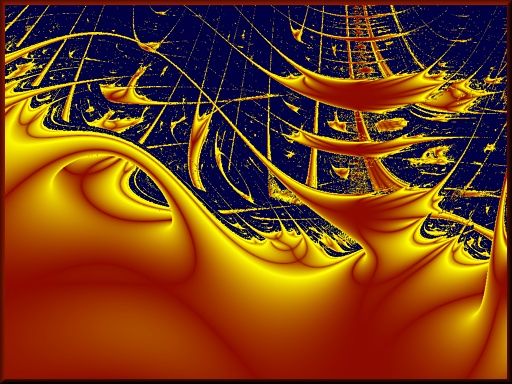
It's correct that Lyapunov images are not fractals in the classic sense of self iterated recursive images, but are true representations of Chaos theory. In starting to piece together an understanding of a Lyapunov function, I went backwards and started with the Lorenz attractor and Lorenz's work in attempting to analyze Deterministic Dynamical Systems. The Lorenz attractor's visual representation is not very interesting, but a fellow by the name of Shaw went a lot further with what we know as strange attractors. I came to find a distinct relationship between attractors and the Lyapunov image. Whereas an image of the chaotic behavior of an attractor is nothing but lines, a Lyapunov image is the representation of the "surface" of that representation. Attractors have the characteristics of a pendulum, rotor, oscillator or whatever in a dynamical system. In looking at a visual representation of an attractor you see where the lines tend to overlap most often and wander off chaotically. So there are areas of stability where the lines overlap. In a Lyapunov image, since you are looking at a surface representation, the lines that overlap are the dark lines that show the stability of the system. This surface image is essentially a cross-section of the lines mapping an attractor's behavior. A 2 axis image of a 4 axis process. What drives this point home is the fact that The Lyapunov function essentially shows the same as a Poincare map. A slice through the tangled heart of an attractor, removing a two-dimensional section. What's left is the surface image of that slice where the stable intersection of points is a line. Lines of stability as previously mentioned. This surface image is not the same as a fractal that can be zomed into with increasing depth. When zooming into a smaler section of a Lyapunov image you are still on the same plane, just zooming into smaller deatail. The image often "breaks up" in detail but not from visual artifacts but from increasing chaos. The most famous images that have sparked interest in Lyapunov images since 1990 has been the work of Mario Markus. http://perso.wanadoo.fr/charles.vassallo/en/lyap_art/lyapdoc.html, and here is a link with software that should replicate his images, http://www.efg2.com/Lab/FractalsAndChaos/Lyapunov.htm If you happen to be an owner of Paul Carlson's Mind-boggling Fractals software, www.mbfractals.com, there is a free program he provides specifically for Lyapunov images that renders them images in the purest form. His email addy is carlson@mbfractals.com. I have atached a version of Mario Markus' "Zircon Zity" rendered in the program. It is a Logistic equation using the string bbbbbbaaaaaa. A fellow by the name of Francois Blais was very successful with Lyapunov images rendered in Fractint, spanky.triumf.ca/www/fractint/fractint.html, and posted some extraordinary work to alt.binaries.picures.fractals several years ago and again recently. I have not seen any of his posts in 2-3 months, but very likely posting a query to him, via that forum, might produce results. I believe he is with the University of Quebec. Some of Stephen Ferguson's programs, http://www.eclectasy.com/Iterations-et-Flarium24/ produce Lyapunov images, too. Lyapunov Java applet: http://www.janthor.de/Lyapunov/ All of the software shown will allow you to change the colors to suit you, and Fractint probably the best. Given the nature of the image, and what is represented, the color range is limited. Some of the best Lyapunov images done on a large scale are often composite images for more interest. You can find some of these with a www.google.com search.
